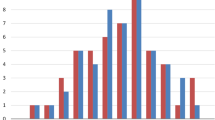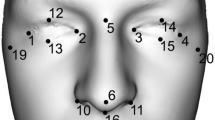Abstract
Aim:
Are centroid size, principal component analysis (PCA) and thin-plate splines (TPS) sufficient for determining facial morphology? Is it possible to identify relationships between cranial morphology, gender and facial profile?
Material and Methods:
Profile photos of 110 adult patients were measured according to A.M. Schwarz landmarks using Onyx Ceph™. Centroid size was calculated from x and y-coordinates. After Procrustes transformation, a principal component analysis for identifying major components of facial morphology was performed and the results visualized using thin-plate splines. At the same time, lateral cephalograms of all patients were analyzed according to Hasund.
Results:
There were significant differences in centroid size betweeen male and female patients. Only the vertical skeletal structure had an impact on centroid size.
Six components (PC1 to PC6) were identified using PCA. They were responsible for 86.5% of the variance. PC1 (33.9%) described scaling along an axis from Porion to chin. PC2 (28.6%) characterized the vertical dimensions of the lower face. Significant differences were only apparent between males and females in PC3 and PC4. In terms of cephalometric parameters, PC2 and PC3 differed in the vertical, and PC1 und PC2 in the sagittal configuration.
Conclusions:
The analyses presented here suffice for describing facial morphology qualitatively and quantitatively as demonstrated by this example. Separating size from shape is useful for investigating therapeutically and growth-related morphological changes. It is difficult to draw conclusions about skeletal parameters.
Zusammenfassung
Zielstellung:
Sind die Zentroidgrose, Hauptkomponentenanalyse (Principal Component Analysis – PCA) und Thin-Plate Splines (TPS) geeignet, die Gesichtsmorphologie adaquat zu beschreiben? Sind Abhangigkeiten vom Schadelaufbau und Geschlecht identifizierbar?
Material und Methodik:
Profilfotos von 110 erwachsenen Patienten wurden mit Onyx Ceph™ anhand modifizierter Messpunkte nach A.M. Schwarz vermessen. An den xy-Koordinaten der Messpunkte wurde die Zentroidgrose der Gesichter bestimmt. Nach Procrustes-Transformation der Koordinaten wurde mittels PCA nach die Gesichtsform bestimmenden Komponenten gesucht und mittels TPS visualisiert. Zeitgleich angefertigte Fernrontgenseitenbilder (FRS) wurden mit der Analyse nach Hasund ausgewertet.
Ergebnisse:
Die Zentroidgrosen zeigten signifikante Unterschiede zwischen Frauen und Mannern. Nur der vertikale Schadelaufbau wirkte sich auf die Zentroidgrose aus.
In der PCA wurden sechs Komponenten (PC1 bis PC6) gefunden, die 86,5% der Varianz erklarten. PC1 (33,9%) war annahrend durch Stauchung und Streckung der Lagebeziehung Porion–Kinn zu erfassen. PC2 (28,6%) kennzeichnete eher die vertikale Entwicklung des Untergesichts. Frauen und Manner unterschieden sich signifikant nur in PC3 und PC4, nicht in den entscheidenden ersten beiden. Bezuglich der Fernrontgenanalyse unterschieden sich PC2 und PC3 signifikant in der Vertikalen, PC1 und PC2 in der Sagittalen.
Schlussfolgerungen:
Die vorgestellten Analysen sind geeignet quantitativ und qualitativ die Gesichtsmorphologie zu beschreiben. Die Trennung von Grose und Form erlaubt die differenzierte Betrachtung von therapiebedingten und wachstumsbedingten Veranderungen. Ruckschlusse auf skelettale Verhaltnisse sind nur eingeschrankt moglich.
Similar content being viewed by others
Author information
Authors and Affiliations
Corresponding author
Rights and permissions
About this article
Cite this article
Krey, KF., Dannhauer, KH. Morphometric Analysis of Facial Profile in Adults. J Orofac Orthop 69, 424–436 (2008). https://doi.org/10.1007/s00056-008-8803-3
Received:
Accepted:
Published:
Issue Date:
DOI: https://doi.org/10.1007/s00056-008-8803-3




